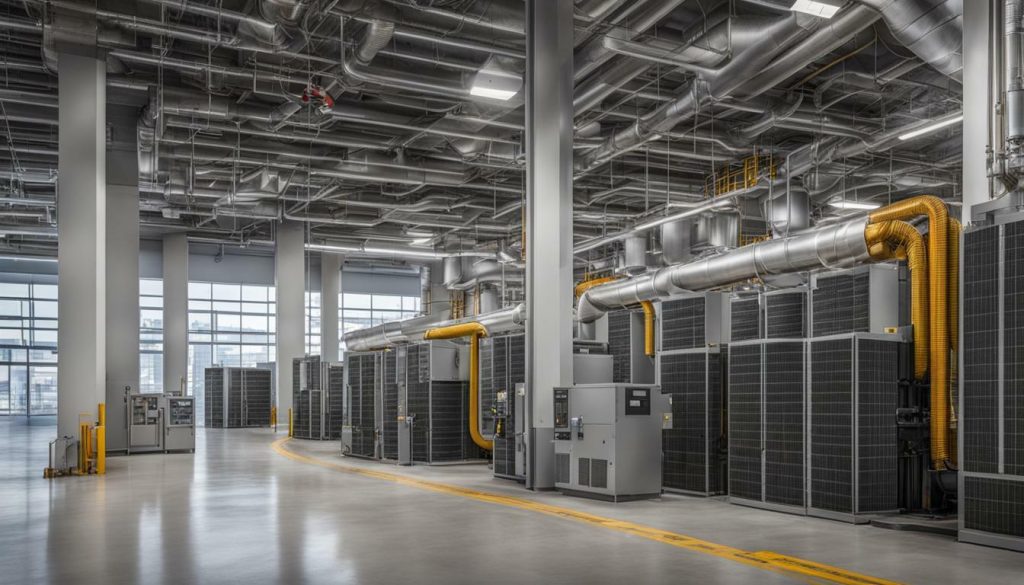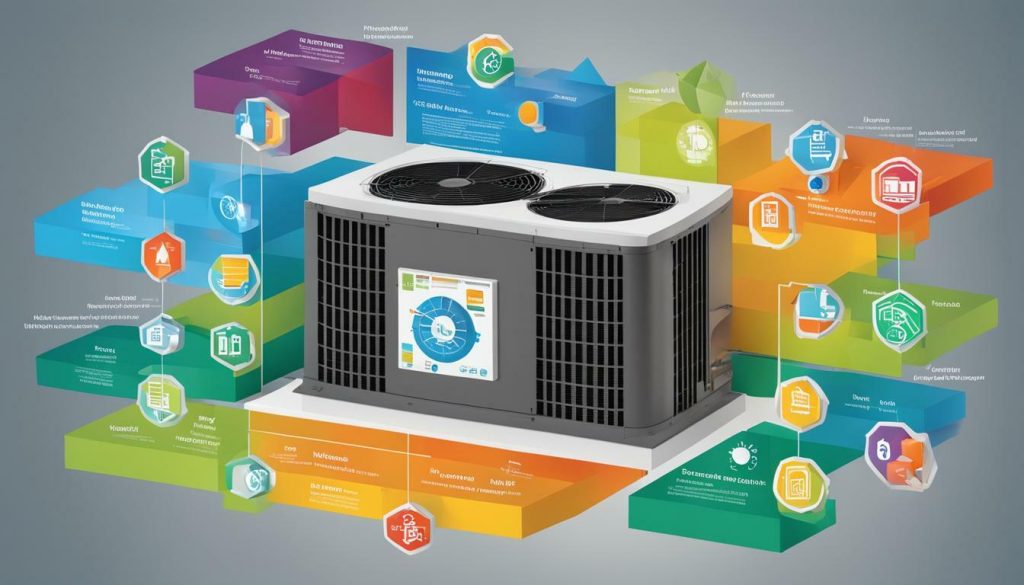When it comes to winning HVAC proposals, contractors need to understand the key elements that can make or break their chances of securing a job. Implementing these elements in the proposal can greatly increase the likelihood of winning more jobs.
The first crucial element is the integration of CRM (Customer Relationship Management) systems into HVAC proposals. This integration streamlines and standardizes the sales process, allowing contractors to effectively manage customer interactions and track the progress of proposals.
An integrated product library is another essential component of a winning HVAC proposal. By having an integrated product library, contractors can ensure accurate pricing and readily accessible product data, enabling them to create more accurate and competitive proposals.
Precise budgeting and accounting practices play a vital role in winning HVAC proposals. Accurate budgeting helps contractors determine the project scope and budget, giving them a better understanding of the financial aspects associated with the job.
Mobile quoting capabilities are also crucial in HVAC proposals. With the ability to create realistic scopes and budgets on-the-go, contractors can provide clients with accurate and timely proposals, increasing their chances of winning the job.
Effective communication is key in any proposal, and HVAC contractors can enhance this by integrating proposal drawing capabilities. These integrations allow contractors to visually represent their proposals, enhancing client understanding and increasing the likelihood of winning the job.
Service plan generation within HVAC proposals can significantly enhance customer retention and convenience. By incorporating service plans, contractors can offer additional value to their clients, increasing the chances of winning more jobs and establishing long-term partnerships.
The use of eSignatures in HVAC proposals streamlines the signature process, making it convenient for clients and increasing the efficiency of winning proposals. With eSignatures, contractors can obtain secure and legally binding signatures without the need for physical documents.
Lastly, contractors can leverage HVAC proposal templates to create professional and persuasive proposals. These templates provide a structured format and guide contractors in presenting their services and pricing effectively, increasing their chances of winning more jobs.
Key Takeaways:
- Integrating CRM systems into HVAC proposals streamlines the sales process.
- An integrated product library ensures accurate pricing and readily accessible product data.
- Accurate budgeting and accounting practices are essential in determining project scope and budget.
- Mobile quoting capabilities enable contractors to provide accurate and timely proposals.
- Proposal drawing integrations enhance communication and visual representation for clients.
The Importance of CRM Integrations in HVAC Proposals
One of the essential elements for winning HVAC proposals is the integration of Customer Relationship Management (CRM) systems, which can significantly improve the overall sales process. By incorporating CRM integrations into HVAC proposals, contractors can streamline and standardize their sales approach, increasing their chances of securing more contracts.
CRM integrations provide a centralized platform for managing customer data, communication, and sales activities. This allows contractors to efficiently track and monitor leads, follow up with clients, and manage the entire proposal process. With CRM integrations, contractors can easily access vital customer information, including contact details, project history, and communication logs, enabling personalized and targeted proposals.
Furthermore, CRM integrations enable contractors to automate various tasks, such as proposal generation, follow-up reminders, and document management. This not only saves time but also ensures consistency and accuracy in proposal creation. Contractors can create professional and persuasive proposals by utilizing predefined templates, inserting customized content, and incorporating pricing and product data from the integrated product library.
Overall, CRM integrations provide HVAC contractors with a powerful tool to enhance their sales process and improve the chances of winning proposals. By leveraging the benefits of CRM technology, contractors can effectively manage customer relationships, streamline proposal creation, and ultimately boost their success rate in securing HVAC contracts.
| Benefits of CRM Integrations in HVAC Proposals |
|---|
| Centralized customer data and communication management |
| Efficient lead tracking and follow-up processes |
| Automated proposal generation and document management |
| Enhanced personalization and customization of proposals |
| Increased consistency and accuracy in proposal creation |
The Benefits of an Integrated Product Library in HVAC Proposals
An often-overlooked element in HVAC proposals that can greatly impact winning strategies is the inclusion of an integrated product library, providing contractors with a competitive edge. Having an integrated product library ensures accurate pricing and readily accessible product data, leading to more accurate and competitive proposals. By utilizing this tool, contractors can simplify the process of selecting the right products for each project, saving time and increasing efficiency.
With an integrated product library, contractors have access to a comprehensive database of HVAC products, including specifications, pricing, and availability. This allows them to quickly find the most suitable products for each project, ensuring that their proposals are tailored to the specific needs of their clients. Moreover, contractors can easily update and manage their product database, ensuring that they always have the most up-to-date information at their fingertips.
In addition to streamlining the proposal process, an integrated product library also helps contractors stay competitive. By having access to accurate pricing information, contractors can ensure that their proposals are priced competitively, giving them an advantage over their competitors. Moreover, the ability to quickly generate accurate quotes based on the product library saves time and reduces the risk of errors, further increasing the chances of winning more HVAC bids.
| Benefits of an Integrated Product Library in HVAC Proposals |
|---|
| Accurate pricing information |
| Readily accessible product data |
| Streamlined proposal process |
| Increased competitiveness |
| Time-saving and error-reducing |
Overall, an integrated product library is an invaluable tool for contractors looking to improve their HVAC proposal writing tactics and increase their chances of winning bids. By utilizing accurate pricing information, readily accessible product data, and streamlining the proposal process, contractors can enhance their competitiveness and efficiency. Incorporating an integrated product library into HVAC proposals is a smart move that sets contractors apart from the competition and helps them secure more winning bids.

The Role of Accurate Budgeting and Accounting in HVAC Proposals
Accurate budgeting and accounting practices play a pivotal role in winning HVAC proposals, as they demonstrate professionalism and meticulousness in estimating project costs. By ensuring that every aspect of the project is accounted for and budgeted accurately, contractors can instill confidence in their clients and differentiate themselves from their competitors.
One important aspect of accurate budgeting and accounting is the ability to accurately estimate material and labor costs. By conducting thorough research and analysis, contractors can provide clients with realistic and competitive pricing, setting themselves apart as reliable and trustworthy partners. Additionally, accurate budgeting allows contractors to allocate resources effectively, ensuring that projects are completed within the agreed-upon timeframes and budgets.
Another key benefit of accurate budgeting and accounting is the ability to identify potential cost savings and efficiencies. By closely monitoring expenses and evaluating previous projects, contractors can identify areas where costs can be reduced without compromising quality. This not only helps to increase the chances of winning proposals but also improves overall profitability and customer satisfaction.
| Benefits of Accurate Budgeting and Accounting |
|---|
| 1. Demonstrates professionalism and meticulousness in estimating project costs |
| 2. Instills confidence in clients |
| 3. Allows for accurate estimation of material and labor costs |
| 4. Identifies potential cost savings and efficiencies |

Implementing effective budgeting and accounting practices is essential for contractors looking to win more HVAC proposals. By showcasing their professionalism and attention to detail, contractors can position themselves as reliable partners who deliver high-quality projects within budget.
The Power of Mobile Quoting Capabilities in HVAC Proposals
In today’s fast-paced world, mobile quoting capabilities have become a game-changer in the HVAC industry and an essential element in winning proposals. With the ability to create realistic scopes and budgets on-the-go, contractors can now impress clients with quick and accurate quotes that showcase their expertise and professionalism.
Mobile quoting capabilities allow salespeople to access product catalogs, pricing information, and project details right at their fingertips. Whether they are on-site, in a meeting, or on the road, contractors can now provide clients with timely and accurate proposals that meet their specific needs.
Furthermore, mobile quoting capabilities streamline the entire proposal process, from initial contact to signing the dotted line. Salespeople can easily create and send proposals, track their status, and even obtain eSignatures, all within the convenience of a mobile device. This not only saves time and effort but also enhances customer experience and satisfaction.

By leveraging mobile quoting capabilities, contractors can demonstrate their professionalism, efficiency, and commitment to customer satisfaction. Whether it’s responding to urgent client requests, providing accurate and competitive pricing, or delivering proposals in a timely manner, mobile quoting capabilities play a vital role in winning more HVAC proposals.
| Benefits of Mobile Quoting Capabilities in HVAC Proposals |
|---|
| 1. Increased efficiency and productivity |
| 2. Real-time access to product catalogs and pricing information |
| 3. Ability to create realistic scopes and budgets on-the-go |
| 4. Streamlined proposal process, from creation to eSignature |
| 5. Enhanced customer experience and satisfaction |
Enhancing Communication with Proposal Drawing Integrations
Proposal drawing integrations have emerged as a powerful tool for HVAC contractors, enabling them to effectively communicate their ideas and concepts to clients, ultimately boosting their success rates in winning proposals. With these integrations, contractors can create visually appealing and detailed drawings that illustrate the proposed HVAC system or solution for the client. By providing clients with a visual representation, contractors can better convey the value of their proposed solution and address any potential concerns or questions that may arise.
One of the key benefits of proposal drawing integrations is the ability to showcase the technical aspects of the proposal in a clear and concise manner. Contractors can create detailed drawings that highlight the placement of HVAC equipment, ductwork, and other components, giving clients a comprehensive understanding of the proposed system’s design and functionality. This not only helps clients visualize the end result but also builds trust and confidence in the contractor’s expertise.
Furthermore, proposal drawing integrations allow for easy collaboration between the contractor and client. Contractors can make real-time adjustments and modifications to the drawings based on client feedback, ensuring that the proposal meets the client’s specific requirements and preferences. This collaborative approach not only strengthens the communication between both parties but also increases the likelihood of winning the proposal as clients feel heard and involved in the decision-making process.
Table 1: Benefits of Proposal Drawing Integrations
| Benefits | Explanation |
|---|---|
| Improved Communication | Clear visual representation facilitates effective communication with clients. |
| Enhanced Understanding | Detailed drawings help clients better understand the proposed HVAC system or solution. |
| Increased Collaboration | Real-time adjustments and modifications based on client feedback facilitate collaboration. |
| Building Trust | Visual representation showcases contractor expertise and builds trust with clients. |
In summary, proposal drawing integrations play a crucial role in enhancing communication and increasing the success rates of HVAC proposals. By utilizing these integrations, contractors can effectively convey their ideas and concepts, address client concerns, and build trust through visually appealing and detailed drawings. The collaborative nature of these integrations also fosters stronger relationships between contractors and clients, ultimately improving the chances of winning proposals.

Boosting Customer Retention and Convenience with Service Plan Generation
Offering comprehensive service plans as part of HVAC proposals not only ensures customer satisfaction but also improves the chances of winning contracts by showcasing the long-term value a contractor can provide. By including service plans in proposals, contractors demonstrate their commitment to delivering ongoing support and maintenance, which is highly valued by clients. Service plans not only help address potential issues and breakdowns but also contribute to the overall efficiency and longevity of HVAC systems.
Service plans can be tailored to meet the specific needs of the client, providing them with peace of mind and convenience. These plans outline regular inspections, maintenance visits, and system tune-ups, which help prevent costly repairs and extend the lifespan of HVAC equipment. By clearly outlining the services included in the plan, contractors can showcase their expertise and build trust with potential clients, ultimately increasing the likelihood of winning contracts.
In addition to improving customer retention, service plans also offer a competitive advantage in the bidding process. Including the service plan details in the proposal can set a contractor apart from competitors and highlight the added value they bring to the table. Clients are more likely to choose a contractor who not only offers installation but also ongoing support and maintenance. This strategic approach reinforces the long-term partnership between the contractor and the client, laying the foundation for future projects and referrals.

Table 1: Sample Service Plan Features
| Service Plan Tier | Services Included | Frequency |
|---|---|---|
| Basic | System inspections and tune-ups | Annually |
| Premium | System inspections, tune-ups, and filter replacements | Bi-annually |
| Ultimate | System inspections, tune-ups, filter replacements, and priority service | Quarterly |
By incorporating service plans into HVAC proposals, contractors can enhance their credibility, showcase their commitment to customer satisfaction, and differentiate themselves from competitors. Offering comprehensive service plans not only ensures customer satisfaction but also provides contractors with a solid foundation for winning contracts and building long-lasting client relationships.
Streamlining the Signature Process with eSignatures in HVAC Proposals
The integration of eSignatures in HVAC proposals significantly simplifies the signature process, providing convenience for clients and improving the overall efficiency of winning strategies. With eSignatures, clients no longer need to print, sign, scan, and email back proposal documents. They can simply review the proposal electronically and sign it with just a few clicks. This not only saves time but also reduces the chances of errors or misplaced documents.
By utilizing eSignatures, contractors can expedite the approval process and move forward with projects more quickly. Time-sensitive projects require prompt decisions, and eSignatures ensure that proposals can be reviewed and signed in a timely manner. This ultimately increases the chances of securing contracts and winning more jobs.
In addition to the convenience it offers, eSignatures also improve the overall efficiency of winning strategies. The use of eSignatures eliminates the need for physical paperwork, reducing administrative tasks and costs. It allows for better organization and tracking of proposal documents, enabling contractors to easily access signed copies when needed. Moreover, eSignatures provide a more professional image, demonstrating that a company is technologically advanced and modern, which can positively influence clients’ perception and trust.

In summary, incorporating eSignatures into HVAC proposals streamlines the signature process, offering convenience for clients and improving the efficiency of winning strategies. By embracing this technology, contractors can enhance their chances of securing contracts and winning more jobs in the highly competitive HVAC industry.
Leveraging HVAC Proposal Templates for Success
HVAC proposal templates are valuable resources that contractors can use to streamline their proposal creation process and develop winning proposals consistently. These templates serve as a framework for organizing and presenting the necessary information in a clear and professional manner. By utilizing HVAC proposal templates, contractors can save time and effort in preparing proposals, allowing them to focus on the critical aspects of their business.
One of the key advantages of using HVAC proposal templates is the ability to maintain consistency in formatting and content. Templates provide a standardized structure that ensures all necessary information is included, such as project details, scope of work, pricing, and terms and conditions. This consistency not only enhances the professionalism of the proposal but also helps to build trust with clients.
Additionally, HVAC proposal templates offer the flexibility to customize and tailor the content to each specific project. Contractors can easily modify sections to highlight their unique strengths, showcase relevant experience, and address specific client requirements. This level of customization allows contractors to create personalized proposals that resonate with potential clients and increase the likelihood of winning the job.
The Benefits of HVAC Proposal Templates:
| Streamline Proposal Creation Process | HVAC proposal templates provide a structured framework, saving time and effort in proposal preparation. |
|---|---|
| Maintain Consistency | Templates ensure a consistent format and content, enhancing professionalism and building client trust. |
| Customization Options | Contractors can tailor templates to individual projects, highlighting strengths and addressing client requirements. |
In conclusion, leveraging HVAC proposal templates can significantly improve the efficiency and effectiveness of the proposal creation process. By streamlining the process, maintaining consistency, and allowing for customization, contractors can develop winning proposals consistently. It’s important to choose templates that align with the specific needs of the business and adapt them as needed for each project. By utilizing these valuable resources, contractors can increase their chances of securing more HVAC contracts and growing their business.

Implementing Effective Strategies for Winning HVAC Proposals
To significantly improve their chances of winning HVAC proposals, contractors must implement a combination of effective strategies that incorporate CRM integrations, integrated product libraries, accurate budgeting and accounting, mobile quoting capabilities, proposal drawing integrations, service plan generation, and eSignatures. These strategies work together to streamline the sales process, enhance communication, and increase customer convenience.
CRM integrations are essential in managing customer relationships and ensuring a standardized sales process. By integrating a CRM system into HVAC proposals, contractors can streamline their workflow, track customer interactions, and effectively manage leads and follow-ups. The use of CRM integrations not only saves time and effort but also improves overall efficiency, resulting in a higher chance of winning proposals.
An integrated product library plays a crucial role in creating accurate and competitive proposals. By maintaining a centralized database of product information, contractors can easily access pricing details, technical specifications, and other relevant data. This ensures that proposals are based on the most up-to-date information, allowing contractors to provide clients with accurate quotes and effectively demonstrate the value of their services.
Accurate budgeting and accounting are vital components of successful HVAC proposals. By carefully evaluating project scope, estimating costs, and accounting for potential expenses, contractors can create realistic budgets that align with client expectations. This level of accuracy not only establishes trust with clients but also increases the likelihood of winning proposals by demonstrating professionalism and thoroughness.
| Key Strategies | Benefits |
|---|---|
| CRM Integrations | Streamline sales process, track customer interactions, and improve overall efficiency. |
| Integrated Product Libraries | Access accurate and up-to-date product information for creating competitive proposals. |
| Accurate Budgeting and Accounting | Establish trust, demonstrate professionalism, and align budgets with client expectations. |
| Mobile Quoting Capabilities | Create realistic scopes and budgets on-the-go, enhancing proposal accuracy. |
| Proposal Drawing Integrations | Enhance communication and provide visual representation for clients. |
| Service Plan Generation | Improve customer retention and convenience, increasing proposal success. |
| eSignatures | Streamline the signature process, making it convenient for clients and increasing proposal efficiency. |
Implementing mobile quoting capabilities allows contractors to create realistic scopes and budgets for clients on-the-go. By utilizing mobile devices, salespeople can assess project requirements, calculate costs, and provide accurate quotes, all while meeting with clients. This level of flexibility and responsiveness not only impresses clients but also ensures that proposals align with client expectations, increasing the chances of winning jobs.
Proposal drawing integrations enhance communication and provide visual representation for clients. By incorporating tools that allow for the creation of detailed project drawings and renderings, contractors can effectively convey their proposed solutions. This visual element not only helps clients understand the project better but also instills confidence in the contractor’s abilities, contributing to a higher success rate in winning proposals.
By offering service plan generation as part of their proposals, contractors can demonstrate their commitment to customer satisfaction and convenience. Service plans provide clients with ongoing support and maintenance options, fostering long-term relationships and increasing the chances of winning proposals. Additionally, incorporating eSignatures into the proposal process streamlines the signature process, making it more convenient for clients and increasing overall efficiency.
By implementing these effective strategies, contractors can significantly enhance their chances of winning HVAC proposals. Combining CRM integrations, integrated product libraries, accurate budgeting and accounting, mobile quoting capabilities, proposal drawing integrations, service plan generation, and eSignatures creates a compelling proposal that stands out from the competition.

HVAC Proposal Best Practices for Success
In addition to the core elements and strategies discussed earlier, there are several best practices that contractors should follow to maximize their chances of winning HVAC proposals.
Clear and Concise Proposal Structure
One of the key best practices is to ensure that your HVAC proposal has a clear and concise structure. Start with a compelling executive summary that highlights the unique value proposition of your solution. Follow with a detailed scope of work, outlining the specific tasks, materials, and timelines involved. Break down the pricing structure in a transparent and easy-to-understand manner. Finally, include a section that highlights your company’s credentials, testimonials, and past project successes. A well-structured proposal not only presents a professional image but also helps the client easily navigate through the information.
Personalized and Customer-Centric Approach
To stand out from the competition, it is essential to personalize your HVAC proposals according to each client’s specific needs and requirements. Take the time to understand their pain points, priorities, and objectives. Tailor your proposal to address these concerns and highlight how your solution can address them effectively. Demonstrating a customer-centric approach not only shows your commitment to meeting their unique needs but also builds trust and credibility.
Professional Design and Visual Elements
Another best practice is to ensure that your HVAC proposal has a professional design and incorporates visual elements. A visually appealing proposal is not only more engaging but also leaves a lasting impression on the client. Use high-quality images, graphics, and charts to illustrate key points, showcase your past projects, and provide a visual representation of your proposed solution. Additionally, consider incorporating your company’s branding elements, such as your logo and color scheme, to create a cohesive and professional-looking document.
By following these best practices and integrating them into your HVAC proposals, you can significantly enhance your chances of winning more jobs. Remember to continuously refine and improve your proposals based on client feedback and industry trends to stay ahead of the competition.

Conclusion
By incorporating CRM integrations, integrated product libraries, accurate budgeting and accounting, mobile quoting capabilities, proposal drawing integrations, service plan generation, and eSignatures, contractors can elevate their business and secure more contracts through winning HVAC proposals.
CRM integrations streamline the sales process, ensuring a more efficient and standardized approach that increases the likelihood of winning proposals. An integrated product library ensures accurate pricing and readily accessible product data, leading to more accurate and competitive proposals. Accurate budgeting and accounting practices are crucial for determining project scope and budget, ultimately increasing the chances of winning proposals.
With mobile quoting capabilities, salespeople can create realistic scopes and budgets on-the-go, enhancing their chances of winning proposals. Proposal drawing integrations enhance communication and provide visual representation for clients, making proposals more compelling and increasing the chances of success. Incorporating service plans enhances customer retention and convenience, further improving the likelihood of winning proposals.
Lastly, eSignatures streamline the signature process, making it convenient for clients and increasing the efficiency of winning proposals. By leveraging these elements and strategies, contractors can create professional and persuasive proposals that stand out from the competition and increase their chances of securing more contracts in the HVAC industry.
FAQ
What elements should be included in HVAC proposals to increase the chances of winning more jobs?
HVAC proposals should include CRM integrations, an integrated product library, accurate budgeting and accounting, mobile quoting capabilities, proposal drawing integrations, service plan generation, and eSignatures.
How do CRM integrations contribute to winning HVAC proposals?
CRM integrations streamline and standardize the sales process, making it more efficient and increasing the likelihood of winning proposals.
What are the benefits of an integrated product library in HVAC proposals?
An integrated product library ensures accurate pricing and readily accessible product data, resulting in more accurate and competitive proposals.
Why is accurate budgeting and accounting important in HVAC proposals?
Accurate budgeting and accounting practices are crucial for determining project scope and budget, increasing the chances of winning proposals.
How do mobile quoting capabilities enhance HVAC proposals?
Mobile quoting capabilities allow salespeople to create realistic scopes and budgets on-the-go, improving the accuracy and competitiveness of proposals.
How do proposal drawing integrations enhance HVAC proposals?
Proposal drawing integrations enhance communication and provide visual representation for clients, increasing the chances of winning proposals.
What is the role of service plan generation in HVAC proposals?
Incorporating service plans in HVAC proposals enhances customer retention and convenience, thereby increasing the likelihood of winning proposals.
How do eSignatures streamline the signature process in HVAC proposals?
eSignatures make the signature process convenient for clients and increase the efficiency of winning proposals.
How can HVAC proposal templates be leveraged for success?
HVAC proposal templates can be used to create professional and persuasive proposals, increasing the chances of winning contracts.
What are some effective strategies for winning HVAC proposals?
Effective strategies for winning HVAC proposals include incorporating CRM integrations, an integrated product library, accurate budgeting and accounting, mobile quoting capabilities, proposal drawing integrations, service plan generation, and eSignatures.
What are some HVAC proposal best practices for success?
HVAC proposal best practices include utilizing HVAC proposal templates, implementing effective strategies, and creating persuasive and compelling proposals.





0 Comments